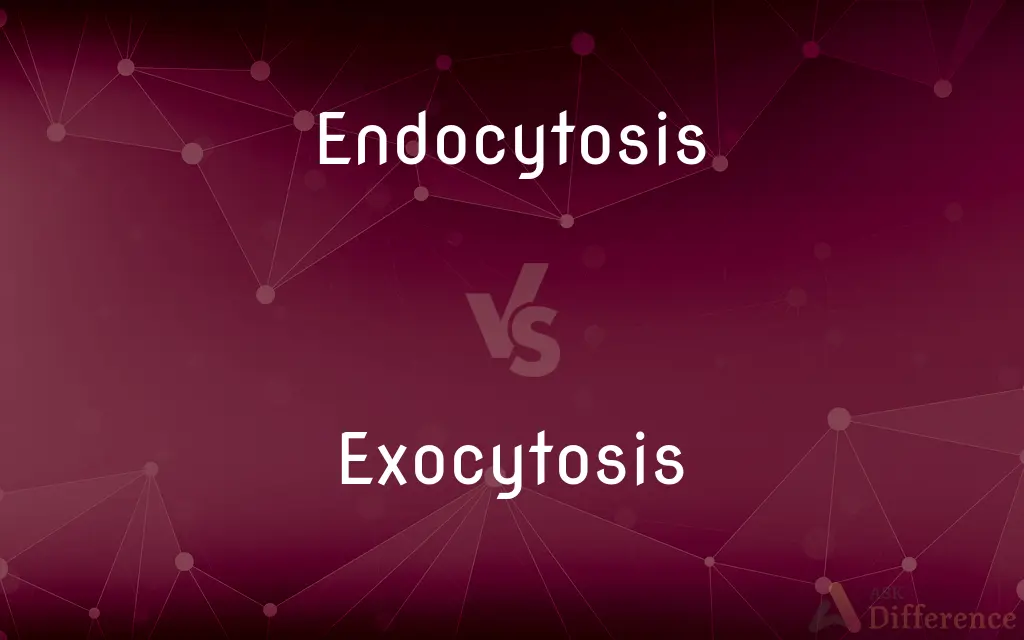Endocytosis vs. Exocytosis — What's the Difference?
By Urooj Arif & Maham Liaqat — Updated on April 15, 2024
Endocytosis involves the cellular process of ingesting materials from the external environment, while exocytosis involves the expulsion of materials from cells to the outside.

Difference Between Endocytosis and Exocytosis
Table of Contents
ADVERTISEMENT
Key Differences
Endocytosis is a cellular mechanism where cells absorb external substances by engulfing them with their membrane. On the other hand, exocytosis is the process by which cells expel materials, such as proteins or waste, by merging vesicles with the plasma membrane.
In endocytosis, the cell membrane folds inward to form a vesicle that encloses extracellular materials. Whereas in exocytosis, vesicles inside the cell fuse with the cell membrane to release their contents outside the cell.
Endocytosis is used by cells to intake nutrients, engage in receptor-mediated signaling, or remove pathogens. On the other hand, exocytosis is essential for processes like neurotransmitter release in nerve cells and secretion of hormones.
Endocytosis can be categorized into phagocytosis, pinocytosis, and receptor-mediated endocytosis, each involving different materials and mechanisms. Exocytosis, however, typically occurs in a more uniform manner regardless of the specific molecules being expelled.
While endocytosis often results in the internalization and sometimes degradation of extracellular substances, exocytosis generally involves the precise release of substances in response to specific cellular signals.
ADVERTISEMENT
Comparison Chart
Primary Function
Intake of materials
Expulsion of materials
Membrane Movement
Membrane folds inward
Vesicles fuse with membrane
Types
Phagocytosis, pinocytosis, receptor-mediated endocytosis
Uniform process
Role in Cell
Nutrient uptake, signaling, pathogen removal
Neurotransmitter release, hormone secretion
Resulting Action
Internalization and degradation
Release of substances externally
Compare with Definitions
Endocytosis
A cellular process where cells absorb materials from the outside by engulfing them with their membrane.
Endocytosis allows a cell to capture a nutrient particle.
Exocytosis
Involves vesicles that fuse with the plasma membrane.
Secretory vesicles in pancreatic cells release insulin through exocytosis.
Endocytosis
Involves the receptor-mediated form for highly specific molecular uptake.
Cells use receptor-mediated endocytosis to selectively absorb cholesterol.
Exocytosis
A process by which cells release substances into the extracellular space.
Exocytosis is vital for neurons to communicate via neurotransmitters.
Endocytosis
Can occur through different mechanisms such as phagocytosis for large particles.
White blood cells use phagocytosis to ingest harmful bacteria.
Exocytosis
Essential for maintaining and modifying the extracellular matrix.
Fibroblasts secrete collagen through exocytosis.
Endocytosis
Allows cells to respond dynamically to external signals.
Cells undergo endocytosis in response to external growth factors.
Exocytosis
Plays a key role in cell signaling and material export.
Exocytosis in immune cells can release signals to attract other immune cells.
Endocytosis
Critical for maintaining cellular environment and defense.
Endocytosis helps cells control their surface composition.
Exocytosis
Regulated by cellular signals to ensure timely substance release.
Muscle cells trigger exocytosis of calcium ions during contraction.
Endocytosis
Endocytosis is a cellular process in which substances are brought into the cell. The material to be internalized is surrounded by an area of cell membrane, which then buds off inside the cell to form a vesicle containing the ingested material.
Exocytosis
Exocytosis () is a form of active transport and bulk transport in which a cell transports molecules (e.g., neurotransmitters and proteins) out of the cell (exo- + cytosis). As an active transport mechanism, exocytosis requires the use of energy to transport material.
Endocytosis
A process of cellular ingestion by which the plasma membrane folds inward to bring substances into the cell.
Exocytosis
A process of cellular secretion or excretion in which substances contained in vesicles are discharged from the cell by fusion of the vesicular membrane with the outer cell membrane.
Endocytosis
(cytology) The process by which the plasma membrane of a cell folds inwards to ingest material.
Exocytosis
(biology) The secretion of substances through cellular membranes, either to excrete waste products or as a regulatory function.
Common Curiosities
Are endocytosis and exocytosis opposite processes?
Yes, in a functional sense, endocytosis and exocytosis are opposite as one involves intake and the other involves expulsion of materials.
Is exocytosis always a continuous process?
Exocytosis can be a continuous or a regulated process depending on the cell type and function.
What triggers exocytosis in cells?
Exocytosis is often triggered by cellular signals or changes in the internal environment, such as a rise in calcium ion levels.
How do cells use endocytosis in receptor-mediated processes?
Cells use receptor-mediated endocytosis to selectively take up specific molecules like hormones or growth factors.
What is the main purpose of endocytosis?
The main purpose of endocytosis is to ingest materials from the external environment into the cell.
Can exocytosis be harmful to the cell?
Generally, exocytosis is beneficial; however, dysregulated exocytosis can contribute to diseases like hypersecretory disorders.
How does exocytosis benefit a cell?
Exocytosis helps cells expel waste, release signaling molecules, and secrete necessary proteins and hormones.
Can endocytosis occur without receptors?
Yes, endocytosis like pinocytosis does not necessarily require specific receptors and is more generalized.
What is phagocytosis?
Phagocytosis is a type of endocytosis where cells ingest large particles or even other cells.
What role does exocytosis play in the nervous system?
Exocytosis is crucial for neurotransmitter release from nerve cells, facilitating nerve impulse transmission.
How are toxins expelled from cells?
Toxins and waste products are often expelled from cells via exocytosis.
How do cells regulate endocytosis and exocytosis?
Cells regulate these processes through various signaling pathways and cellular machinery to ensure proper timing and function.
What is pinocytosis?
Pinocytosis is the process of endocytosis that involves the intake of liquid from the surrounding environment.
What is the difference between endocytosis and phagocytosis?
Endocytosis includes various forms of cellular intake, while phagocytosis specifically refers to the ingestion of large particles or cells.
Can all cells perform exocytosis?
Most eukaryotic cells have the ability to perform exocytosis, but the specifics can vary widely.
Share Your Discovery

Previous Comparison
Astrologer vs. Chaldean
Next Comparison
Autogamy vs. GeitonogamyAuthor Spotlight
Written by
Urooj ArifUrooj is a skilled content writer at Ask Difference, known for her exceptional ability to simplify complex topics into engaging and informative content. With a passion for research and a flair for clear, concise writing, she consistently delivers articles that resonate with our diverse audience.
Co-written by
Maham Liaqat













































